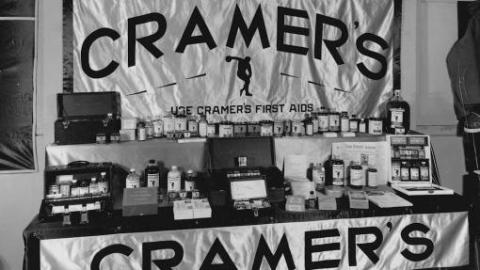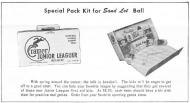
By Matt Webber, ATC
Athletic training kits have been around almost as long as athletic training. Initially, and for quite some time afterward, they were usually a leather physician’s satchel. Athletic trainers were known to carry whatever could possibly be needed to complete their duties. While this may not seem possible in those small bags, we athletic trainers have been known for a long time for our ability to put a lot in a field kit.
In 1911, William “Doc” Buckner of the Chicago White Sox was said to have in his bag “some kind of remedy for almost anything that can happen to a ball player.” In 1937, Lilburn “Lil” Dimmitt of Texas A&M was reported to have a kit he called his “hit and run bag,” with “just about everything needed for a major operation but an operating table.” In 1938, the original NATA reminded athletic trainers to check and stock their kits daily.
In the 1920s, commercial athletic training kits began to appear. The Bullock Brothers Athletic Training Supply Company (founded by Illinois athletic trainer Matt Bullock and his brother) offered an “indestructible first aid kit for field use.” Dr. Samuel Bilik (author of the Trainers Bible) founded the Athletic Trainers Supply Company that offered a “Trainer’s Field Handbag.” It was claimed that more than1,200 had been sold empty for $15 and $22.50 for a “fully equipped” kit.
The Cramer Chemical Company, now Cramer Products, began producing kits for athletic trainers in the 1930s. They have produced dozens of popular models over the intervening eight decades, including the much used metal “varsity kit.” They even produced a cardboard kit, which sounds strange until you have a team lose a kit. Cramer still has a wide variety of athletic training kits that they sell.
A major change was in the 1980s, when soft-sided kits became available. It appears that Bushwalker Manufacturing was the first to produce this style kit, at the behest of Patty Curtiss of Northern Arizona University. Many companies have produced their own style of these kits to serve the needs of athletic trainers.
Finally, someone thought of the idea of putting wheels on athletic training bags. Thank God. For those of us who hauled around heavy kits, because we can cram a lot in them, this was a great back saver. And now we can put even more in them, but I am still trying to figure out how to get a table in there!
Interested in more athletic training history? Visit Matt Webber's website, athletictraininghistory.com. You can buy his book about the early history of the profession HERE.
Posted by NATA News Managing Editor Jaimie Siegle (jaimies@nata.org)
Photos below courtesy of Matt Webber, ATC, and Cramer Products







